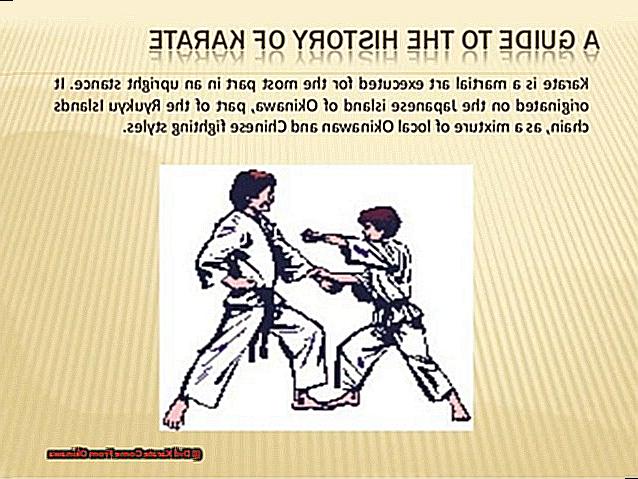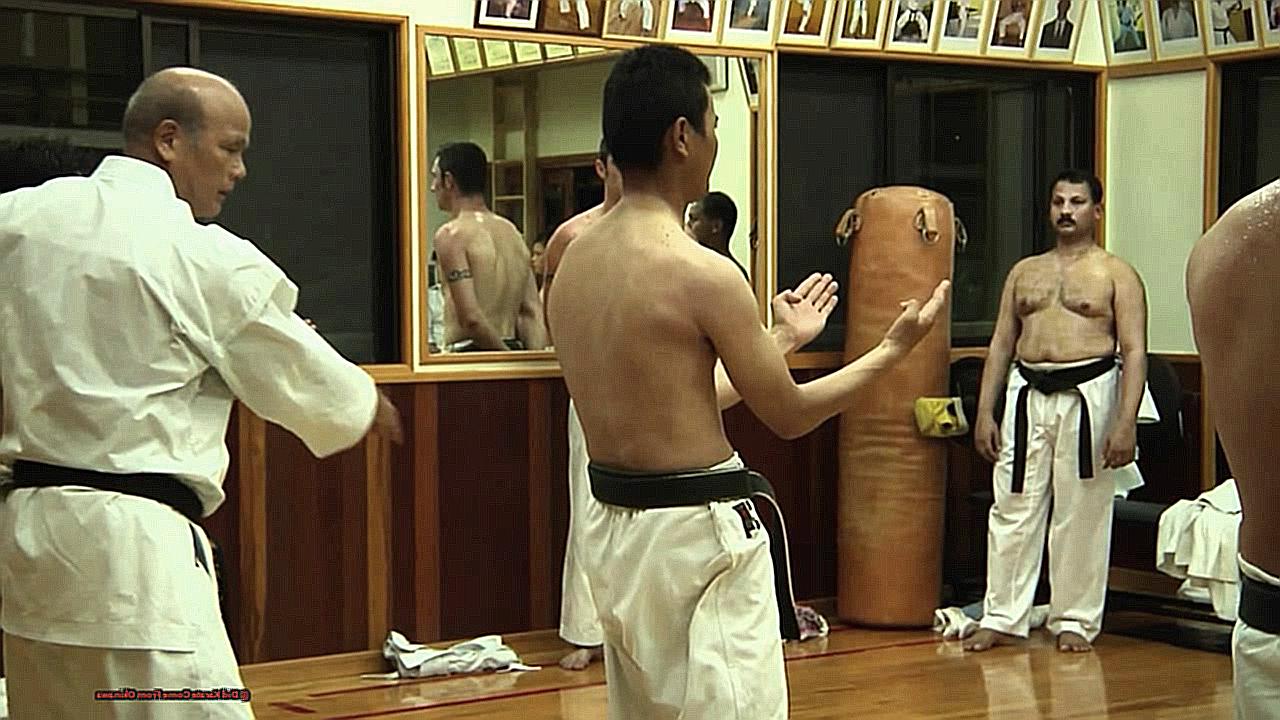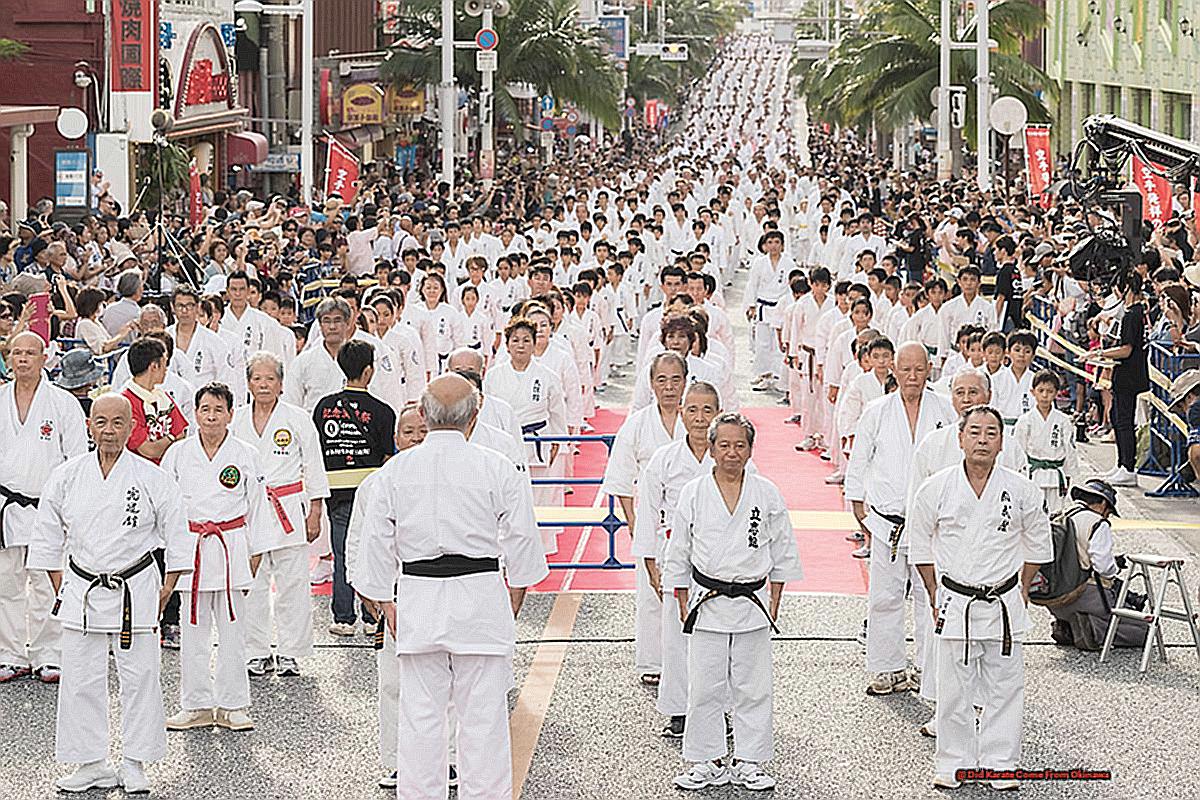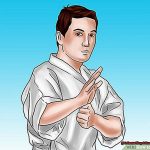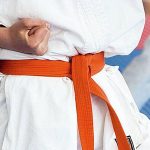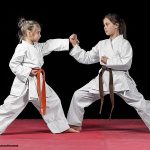Today, we’ll be delving into the origins of karate in Okinawa, Japan – a rich and ancient form of self-defense that continues to enthrall people across the globe. So buckle up and get ready to learn about the roots of this powerful art with us.
Karate traces its beginnings back to Okinawa during the Ryukyu Kingdom era, where it was heavily influenced by Chinese martial arts and indigenous fighting styles. The term “karate” itself translates to “empty hand,” highlighting its emphasis on unarmed combat. As it evolved over time, karate was introduced to Japan in the late 19th century and eventually spread worldwide.
Throughout its development, various masters have left their mark on karate, each with their unique style – such as Shotokan and Goju-Ryu. But karate wasn’t just about physical techniques; it also served as a means of mental training, promoting discipline and character development.
Today, karate has become a global phenomenon with millions of practitioners worldwide and even earning a spot as an Olympic sport. But its origins in Okinawa still hold a special place in its history and continue to inspire those who practice it.
So join us as we uncover more about the fascinating roots of karate in Okinawa. Get ready to be captivated by this timeless art form that has stood strong for centuries. Let’s dive into the depths of its history together.
Did Karate Come From Okinawa?
The question of where karate truly originated from has long been a subject of debate, with some claiming its roots in Okinawa and others in China. However, evidence suggests that Okinawa, now a part of Japan, played a significant role in the development of this martial art. Let’s take a closer look at the evidence for both arguments.
| Origin | Evidence |
| Okinawa | – Okinawa was once an independent kingdom with a strong focus on self-defense techniques and a ban on weapons – This led to the development of unique unarmed techniques by Okinawan masters – The island’s cultural exchange with China also influenced the evolution of karate |
| China | – According to some theories, karate was brought to China by a Buddhist monk named Bodhidharma – This monk is credited with introducing Kung Fu to China, which later made its way to Okinawa – Similar techniques and movements between Kung Fu and karate suggest cultural exchange between the two regions |
While the exact origins may still be up for debate, it is clear that Okinawa played a crucial role in shaping karate into the popular martial art it is today. Its unique history, cultural exchange, and values have all contributed to the evolution of this self-defense style.
Debunking the Myth: Did Karate Really Come from China?
There is a wealth of compelling evidence that debunks the myth of karate’s Chinese origins, pointing instead to Okinawa as its birthplace. This evidence is rooted in the island’s rich history, the influence of Chinese martial arts on Okinawan culture, historical documents, and the deep cultural connection between Okinawa and karate.
One of the most significant pieces of evidence is Okinawa’s distinct history that sets it apart from China. The island was a unique kingdom with its own political structure and customs, making it highly unlikely that karate originated from China. Additionally, the influence of Chinese martial arts on Okinawan culture was minimal and mainly confined to specific regions, further disproving the notion that karate came from China.
Furthermore, historical documents such as the “Okinawan Bubishi” provide detailed accounts of karate’s development in Okinawa, further dispelling any claims of Chinese origin. These documents also highlight the cultural significance of karate in Okinawa, showcasing its deep roots in the island’s traditions and values.
Moreover, the cultural connection between Okinawa and karate cannot be ignored. The concept of “bushi,” or warrior class, is deeply ingrained in Okinawan culture and serves as a foundation for the development of karate.
This cultural link is further solidified by the fact that many prominent karate masters were born and raised in Okinawa.
The Unification of Okinawa and Its Impact on Karate Development
The unification of Okinawa, also known as the Ryukyu Kingdom, played a pivotal role in shaping the evolution of karate as a martial art. This period, spanning from the late 15th century to the late 19th century, saw Okinawa undergo significant cultural and political changes that laid the groundwork for the development of karate.
During this time, the unification of Okinawa in the late 15th century resulted in the prohibition of private weapon ownership and storing of swords in Shuri. This forced the islanders to find alternative ways to protect themselves, ultimately giving rise to unarmed combat techniques that would later become known as karate.
Okinawa’s strategic location as a trading hub exposed its inhabitants to various martial arts from Southeast Asian countries. These influences were assimilated into Okinawan te or hand, further shaping its progression into karate.
Moreover, Chinese traders and diplomats also shared their knowledge and skills in martial arts with the Okinawans during this period. This exchange contributed significantly to the refinement and development of te and its eventual transformation into karate.
As a result of the government abolishing the sword smithy and forbidding weapon imports, there was a shift from focusing on self-defense to competing in karate. This led to the development of various styles, with some masters emphasizing competition while others retained a traditional approach.
In the late 19th century, Gichin Funakoshi introduced karate to Japan, laying the foundation for what would later become known as Shotokan style. This marked a significant milestone in the spread and advancement of karate as a martial art.
Without the unification of Okinawa, it is highly likely that karate would not have evolved into the renowned martial art it is today. The diverse influences and exchanges during this period played a critical role in shaping its development and spread.
The Role of Gichin Funakoshi in Introducing Karate to Mainland Japan
Gichin Funakoshi’s unwavering commitment, persistence, and belief in the art of karate played a pivotal role in its introduction from Okinawa to mainland Japan.
As a highly skilled and esteemed karate master, Funakoshi brought the discipline to mainland Japan, where it gained immense popularity and ultimately paved the way for the establishment of the first official Shotokan Dojo in Tokyo. Through his tireless efforts, he also secured permission for Karate-do to be taught at universities, further cementing its presence on mainland Japan.
With his teachings and demonstrations, he emphasized that Karate-do was not just a fighting style but a way of life. This philosophy deeply resonated with many individuals, leading to the widespread growth and development of karate throughout Japan and eventually across the globe.
Funakoshi’s contributions to karate are immeasurable as he played a crucial role in bringing this martial art from its origins in Okinawa to becoming a globally recognized discipline. Funakoshi’s unwavering dedication and belief in Karate-do were evident in his efforts to introduce it to mainland Japan.
As a highly skilled and respected karate master, he tirelessly promoted the art, leading to its widespread popularity and eventual establishment of the first official Shotokan Dojo in Tokyo. His relentless determination also helped secure permission for Karate-do to be taught at universities, solidifying its presence on mainland Japan.
This philosophy struck a chord with many individuals, resulting in the spread and development of karate across Japan and eventually around the world.
Cultural Exchange: How Okinawan Culture Shaped Karate
The island of Okinawa boasts a vibrant and distinctive culture that has greatly impacted the evolution of karate as a form of martial art. This can be observed in the techniques, philosophy, and values of karate, all of which have their roots in Okinawan culture.
Techniques:
The Okinawans developed karate as a means of self-defense against their rulers who had imposed a ban on weapons on the island. This led to the creation of techniques that incorporated various strikes, kicks, and blocks utilizing different parts of the body. These techniques were greatly influenced by the Chinese martial arts that were introduced to Okinawa through cultural exchange and trading.
Philosophy:
For the Okinawans, karate was not just a form of combat but a way of life. They believed in developing themselves physically, mentally, and spiritually through the practice of karate. This philosophy is deeply rooted in the indigenous belief system of Okinawa, which emphasizes personal growth and self-improvement.
Values:
The values of discipline, respect, and humility are deeply ingrained in Okinawan culture and are reflected in the practice of karate. Students are taught to show respect to their instructors, fellow students, and opponents. Discipline is also emphasized during training to cultivate mental fortitude and focus. Humility is also a crucial value as it teaches students to be humble in both victory and defeat.
The influence of Okinawan culture is also evident in the names of techniques and kata (forms) used in karate. Many have their origins in the Okinawan language and culture, such as “Seisan” (13), “Naihanchi” (internal divided conflict), and “Sanchin” (three battles).
Furthermore, Okinawan culture played a significant role in shaping karate into the martial art it is today.
Beyond Physical Combat: The Values and Traditions Embedded in Karate
| Beyond Physical Combat: The Values and Traditions Embedded in Karate | Exploration | Illustrations |
| Tenacity | Karate emphasizes the importance of grit, determination, and resilience in achieving one’s objectives. | – Overcoming physical and mental obstacles during practice
|
| Admiration | Respect is deeply ingrained in the art of Karate, encompassing self-respect, respect for others, and admiration for the art itself. | – Bowing as a sign of reverence before and after training
|
| Self-Control | Karate promotes self-control through thorough training, cultivating discipline and accountability in practitioners. | – Abiding by strict codes of conduct during practice
|
| Dignity and Uprightness | Karate instills a strong sense of dignity and integrity in its practitioners, highlighting the significance of upholding moral values even in challenging situations. | – Refraining from using Karate for hostility or violence
|
Karate is not solely a physical pursuit, but a lifestyle that encourages the cultivation of strong character and values. The traditional values and practices entrenched in Karate transcend physical combat and have a profound impact on the personal and professional lives of those who practice it. Through rigorous training, individuals learn to embody values such as tenacity, admiration, self-control, and dignity in every aspect of their lives.
Evidence and Support for the Connection Between Okinawa and Karate
The historical bond between Okinawa and karate is deeply rooted, with the island being widely recognized as the birthplace of this martial art. During the 14th century, the Ryūkyū Kingdom, situated in present-day Okinawa, served as a vital trading hub between China and Japan, resulting in frequent cultural exchanges between the two countries. These exchanges often involved the sharing of various fighting techniques.
One of the earliest forms of hand-to-hand combat in Okinawa was known as “te”, which was originally utilized by the indigenous people to fend off invading forces. Over time, te evolved into the modern-day karate we know today, incorporating elements from Chinese martial arts such as kung fu, as well as Japanese martial arts like judo and jujutsu.
In addition to written records dating back to the 18th century, which document the practice of karate on the island, there is also physical evidence of its existence in Okinawa. The island is home to several renowned dojos (training halls) that have been passed down through generations of karate masters. These dojos stand as a testament to the rich history and lineage of karate in Okinawa.
Furthermore, Okinawa has produced numerous prominent figures in the world of karate, including Gichin Funakoshi, who is credited with introducing karate to mainland Japan in the early 20th century. Funakoshi’s teachings and legacy continue to influence the development and global spread of karate.
Conclusion
In conclusion, the roots of karate can be traced back to the island of Okinawa in Japan, where it was heavily influenced by Chinese martial arts and indigenous fighting styles. Over time, this ancient form of combat spread to Japan and eventually became a global phenomenon with millions of practitioners worldwide. Despite its widespread popularity, the origins of karate in Okinawa remain deeply ingrained in its history and continue to inspire those who practice it.
Through cultural exchanges and the unification of Okinawa, this martial art has evolved into a powerful form of self-defense that also promotes discipline and character development.
The evidence supporting Okinawa’s crucial role in shaping karate is abundant – from historical records to physical dojos passed down through generations. While there may be some debate about its exact origins, one thing is clear – Okinawa remains an integral part of this captivating world of martial arts.
So let’s continue our journey together and delve deeper into the fascinating roots of karate on this beautiful island.

